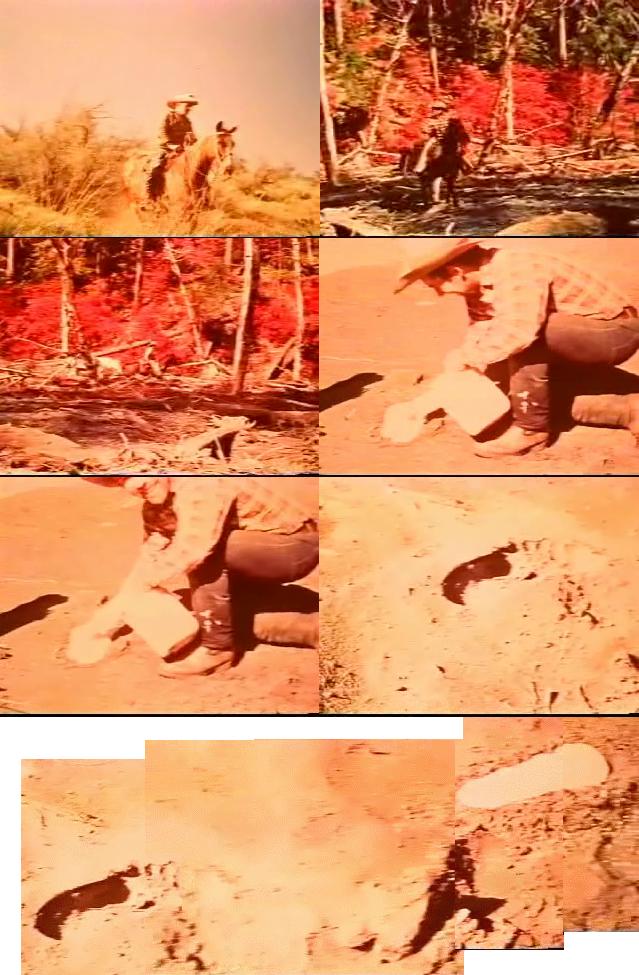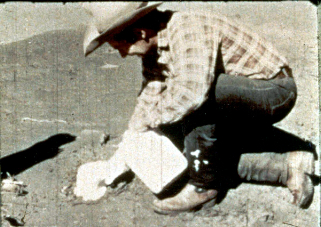

June 23, 2008


Talking of the photographs above, the so-called “Bigfoot Skeptic” this month writes:
These are the tracks that Patterson claimed the Bigfoot made from his famous 1967 film. Notice the toes. How smooth and perfectly shaped they are. Also notice that despite the deep impression of the foot, the only part of the toe that shows in the plaster is the round tips of the toe. No other part of the toe is seen in the deep plaster cast. This suggests that it was not made by an actual fleshly foot stepping down and putting weight down. Shouldn’t the toes smoosh into each other, not maintain a perfect round form, and show more than just the tips of the toe from such a deep impression?
Okay, first of all, do any of these debunkers do their homework? Do Bigfoot researchers realize part of the problem faced today is the “trophy” mentality and legacy of the early folks who collected Bigfoot track casts? It is good to know as much about the history of these cryptozoological artifacts, as possible, before critiquing them.
A variety of things are going on with the track casts from the Patterson-Gimlin filmsite trackway. Let’s look at two areas to pay attention to, in studying these casts.

(1) Back in the 1960s, Bob Titmus, who was the taxidermist who first began taking plaster casts of Bigfoot tracks in the Bluff Creek area, had a “trophy” mentality with regard to the footprints being cast. The absolute best track to take and keep was the one that showed the whole foot, he felt.
Most photos from the 1950s and 1960s show Bigfoot eyewitnesses holding up what were considered, at the time, the “best” casts. These were seen as the ultimate proof, because the “whole feet” casts were well-formed and perfect. (We now know the opposite is actually true. The more movement shown in a cast, the more we learn of the real animal.)

The “Patterson-Gimlin filmsite” casts most often sold today (per above) continue a tradition begun by Bob Titmus of picking out the most “perfect” casts.

Titmus also treated these “trophy tracks” as items to be “cleaned up” and some of the early letters talk of Titmus “scrubbing up” the casts. He wanted to have them without imprefections, to be presented as white, smooth objects. Titmus, furthermore, actually sold cast copies from the very beginning, and some examples from that time demonstrate the cast surfaces were worked on to look smooth, with plaster edges trimmed.

(2) Secondly, and perhaps more importantly in the case of these Bluff Creek tracks, there were more than just the two examples being held by Patterson above.

(Go here to view the clip of the film showing Roger Patterson casting these tracks and speaking of his sighting.)
Dr. Grover Krantz and Dr. Jeff Meldrum have both written extensively about how the trackway of where the Patterson-Gimlin Bigfoot walked included a series of tracks. Krantz and Meldrum detailed how the filmsite track casts capture animate feet, not ones that were created by a fixed fake set of feet, as would have been expected with fake feet being used.
The skeptics and debunkers with questions about the Patterson-Gilmin film trackway casts merely have to look at the plaster of Paris imprints and the surviving photos of the filmsite that have been displayed in several books. They show little evidence of fakery, and clearly the tracks were not made by a fixed fake pair of feet.

Krantz published the trackway casts in his books.

Meldrum, Chris Murphy, and others have brought forth photographs taken at the time of the varied tracks left at Bluff Creek on October 20, 1967. Meldrum is interested in proving his mid-tarsal break theory, but looking beyond that, study what he has published. Examine how different the tracks are, because it was a live primate, not a man in a suit wearing rigid fake feet.

About Loren Coleman
Loren Coleman is one of the world’s leading cryptozoologists, some say “the” leading living cryptozoologist. Certainly, he is acknowledged as the current living American researcher and writer who has most popularized cryptozoology in the late 20th and early 21st centuries.
Starting his fieldwork and investigations in 1960, after traveling and trekking extensively in pursuit of cryptozoological mysteries, Coleman began writing to share his experiences in 1969. An honorary member of Ivan T. Sanderson’s Society for the Investigation of the Unexplained in the 1970s, Coleman has been bestowed with similar honorary memberships of the North Idaho College Cryptozoology Club in 1983, and in subsequent years, that of the British Columbia Scientific Cryptozoology Club, CryptoSafari International, and other international organizations. He was also a Life Member and Benefactor of the International Society of Cryptozoology (now-defunct).
Loren Coleman’s daily blog, as a member of the Cryptomundo Team, served as an ongoing avenue of communication for the ever-growing body of cryptozoo news from 2005 through 2013. He returned as an infrequent contributor beginning Halloween week of 2015.
Coleman is the founder in 2003, and current director of the International Cryptozoology Museum in Portland, Maine.
Filed under Bigfoot, Breaking News, Cryptomundo Exclusive, Cryptotourism, CryptoZoo News, Cryptozoologists, Cryptozoology, Footprint Evidence, Photos, Public Forum, Reviews, Sasquatch